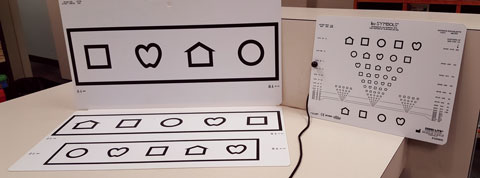 |
To prescribe or not to prescribe? That is the question! Every clinician who treats children on a regular basis frequently faces this dilemma. In the case of most adults, you can simply ask and trust their responses as to whether a new prescription, or a change in their existing one, improves their vision. But for young children, you must rely mostly on objective testing to confirm what the parents, teachers, pediatricians and, yes, the children themselves tell you. Here, we present two cases to shine a spotlight on the gray areas in prescribing for young children.
Case 1
A four-year-old presented for their first exam. The parent reported that the patient had failed a school vision screening, but no documentation was provided to support this. Visual acuity was 20/30 OD, OS, and OU at distance and near with Lea symbols, a shape-based chart. Stereopsis testing showed 30 seconds with the Wirt circles, and the near point of convergence showed a break at 2cm with a recovery at 4cm all three times the test was done. Cover test was orthophoric at distance and near. Amplitude of accommodation was 12 diopters with both the right and left eyes, which was a bit less than expected. Refractive data was:
- Student’s retinoscopy: +2.25 -1.00x015, +2.25 -1.00x160
- Cycloplegic retinoscopy: +3.00 -1.00x010, +2.75 -1.00x160
- Doctor’s retinoscopy: +1.50 -1.00x015, +1.25 -1.00x160
- Final Rx: +1.00 -1.00x015, +0.75 -1.00x160.
 |
| Fig. 1. LEA symbol charts for distance and near. |
The acuity with any of the above was 20/30 OD, OS, OU, at distance and near. What would you do if this child were sitting in your chair?
Case 2
A five-year-old patient presented for their first examination with the parent reporting that their child failed a school vision screening, but as in the first case, no documentation was provided to support the claim. Visual acuity was 20/50 OD, OS, OU at distance and near with Lea symbols. Testing of stereopsis, near point of convergence and amplitude of accommodation were attempted, but the child did not follow instructions or reply in a way that gave specific clinical data. Cover test was orthophoric at distance and near. The refractive data was as follows:
- Student’s retinoscopy: +1.50 -1.00x180, +1.50 -1.00x170
- Doctor’s retinoscopy: +1.50 -1.00x180, +125 -1.00x180
- Final retinoscopy: +1.00 -1.00x180, +1.00 -1.00x180
- Final Rx: +0.50 -1.00x180, +0.50 -1.00x180
Acuity for each combination was 20/20 OD, OS, OU, at distance and near. What would you do?
| Table 1. Some Refractive Errors are Amblyogenic Concerns | |||
| Isometropia | Anisometropia | ||
| Myopia | Greater than 3.50D | Myopia | Greater than 3.00D |
| Hyperopia | Greater than 2.00D | Hyperopia | Greater than 1.00D |
| Astigmatism | Greater than 1.50D | Astigmatism | Greater than 1.00D |
Should I Prescribe?
Little evidence-based medicine exists to guide clinicians. The guidelines for refractive amblyopia do not really help us in either case. High refractive error, or that which would be considered an amblyogenic factor, is shown in Table 1. Since both of our pediatric patients’ refractive errors fell below the levels of worry for hyperopia and astigmatism, we had to rely on our own decision-making process.
In case 1, given that the amplitude of accommodation was low and the cover test showed orthophoria at near, a prescription was warranted. The patient was trial-framed in the office and the increase in visual attention to books was instantaneous. You might be thinking we were wrong to prescribe, as acuity did not improve. We caution not to have too much faith in visual acuity in a younger patient. Instead, make a decision based on what you see taking place in the examination room. Since we both fall into the category of “less is more,” we attempt to provide the least amount of plus or minus that allows clear, single binocular vision. Since the lower amount of hyperopia led to the same acuities and visual behavior, we prescribed that amount.
When the patient returned several months later, the parent was unsure if the glasses were helping but reported that they were worn constantly and that the she did not take them off and lose them, as many children do! The visual acuity was 20/25 OD, OS, and OU at distance and near. We will see the child for her yearly examination next year.
In case 2, given the improvement in visual acuity and the orthophoric posture on cover test, we once again decided to prescribe glasses for full-time use. Could we have held off, given the visual acuity needs of the child? Yes. At this age, in-school near materials contain larger print and fewer words per page, and writing on a board is quite large. We could have waited until the child was in first grade; however, given the change in acuity observed in-office, we gave the final Rx above. The parent reported good compliance when the child was seen several months later—we typically schedule these types of patients back this soon. While scratched and bent several times, the glasses were well tolerated.
While we decided to prescribe for both these children, arguments can be made to not do so. When evaluating your youngest patients, you must use a mixture of objective and subjective testing if the child is cooperating and you think the child is providing quality responses. Aside from the red-flag amblyogenic refractive errors, judgment lies with the clinician. Keep in mind that once you make the choice to give or hold back a prescription, you can always change your mind at the follow-up visit once more data has been collected. Learn to embrace the art and science of prescribing!
